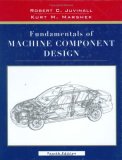Author's Homepage: Kurt M. Marshek
Chapter 9: Surface Damage
"Previous chapters have dealt with damage occurring within the body of a part (yielding, fracture, excessive deflection, buckling). In addition, various kinds of damage can occur to the surface of a part, which render it unfit for use. To being the list, the surface may corrode, either in a normal atmosphere or in other, usually more corrosive, environments such as salt water. Surface corrosion may combine with static or fatigue stresses to produce a more destructive action than would be expected by considering the actions of corrosion and stress separately. High relative velocities between solid parts and liquid particles can cause cavitation of the liquid, which may be destructive to the surface of the part. When two solid members are pressed together, contact stresses are produced, and these require special consideration. When the members are in sliding contact, several types of deterioration coming under the general heading of wear can occur. The severity of wear can be reduced by using a lubricant (as an oil, grease, or solid film) between the rubbing surfaces."



 or by typing Shift Enter.
or by typing Shift Enter.